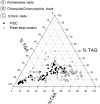Role of premature stop codons in bacterial evolution
- PMID: 18708500
- PMCID: PMC2566208
- DOI: 10.1128/JB.00682-08
Role of premature stop codons in bacterial evolution
Abstract
When the stop codons TGA, TAA, and TAG are found in the second and third reading frames of a protein-encoding gene, they are considered premature stop codons (PSC). Deinococcus radiodurans disproportionately favored TGA more than the other two triplets as a PSC. The TGA triplet was also found more often in noncoding regions and as a stop codon, though the bias was less pronounced. We investigated this phenomenon in 72 bacterial species with widely differing chromosomal GC contents. Although TGA and TAG were compositionally similar, we found a great variation in use of TGA but a very limited range of use of TAG. The frequency of use of TGA in the gene sequences generally increased with the GC content of the chromosome, while the frequency of use of TAG, like that of TAA, was inversely proportional to the GC content of the chromosome. The patterns of use of TAA, TGA and TAG as real stop codons were less biased and less influenced by the GC content of the chromosome. Bacteria with higher chromosomal GC contents often contained fewer PSC trimers in their genes. Phylogenetically related bacteria often exhibited similar PSC ratios. In addition, metabolically versatile bacteria have significantly fewer PSC trimers in their genes. The bias toward TGA but against TAG as a PSC could not be explained either by the preferential usage of specific codons or by the GC contents of individual chromosomes. We proposed that the quantity and the quality of the PSC in the genome might be important in bacterial evolution.
Figures




Similar articles
-
Stop codons in bacteria are not selectively equivalent.Biol Direct. 2012 Sep 13;7:30. doi: 10.1186/1745-6150-7-30. Biol Direct. 2012. PMID: 22974057 Free PMC article.
-
Bacterial phylogenetic tree construction based on genomic translation stop signals.Microb Inform Exp. 2012 May 31;2(1):6. doi: 10.1186/2042-5783-2-6. Microb Inform Exp. 2012. PMID: 22651236 Free PMC article.
-
Stop Codon Usage as a Window into Genome Evolution: Mutation, Selection, Biased Gene Conversion and the TAG Paradox.Genome Biol Evol. 2022 Aug 3;14(8):evac115. doi: 10.1093/gbe/evac115. Genome Biol Evol. 2022. PMID: 35867377 Free PMC article.
-
Variation in Release Factor Abundance Is Not Needed to Explain Trends in Bacterial Stop Codon Usage.Mol Biol Evol. 2022 Jan 7;39(1):msab326. doi: 10.1093/molbev/msab326. Mol Biol Evol. 2022. PMID: 34751397 Free PMC article.
-
Protein Mis-Termination Initiates Genetic Diseases, Cancers, and Restricts Bacterial Genome Expansion.J Environ Sci Health C Environ Carcinog Ecotoxicol Rev. 2015;33(3):255-85. doi: 10.1080/10590501.2015.1053461. J Environ Sci Health C Environ Carcinog Ecotoxicol Rev. 2015. PMID: 26087060 Review.
Cited by
-
Stop codons in bacteria are not selectively equivalent.Biol Direct. 2012 Sep 13;7:30. doi: 10.1186/1745-6150-7-30. Biol Direct. 2012. PMID: 22974057 Free PMC article.
-
Refining the Ambush Hypothesis: Evidence That GC- and AT-Rich Bacteria Employ Different Frameshift Defence Strategies.Genome Biol Evol. 2018 Apr 1;10(4):1153-1173. doi: 10.1093/gbe/evy075. Genome Biol Evol. 2018. PMID: 29617761 Free PMC article.
-
The diverse phenotypic and mutational landscape induced by fluoroquinolone treatment.mSystems. 2025 Aug 19;10(8):e0071325. doi: 10.1128/msystems.00713-25. Epub 2025 Jul 31. mSystems. 2025. PMID: 40742148 Free PMC article.
-
Natural selection retains overrepresented out-of-frame stop codons against frameshift peptides in prokaryotes.BMC Genomics. 2010 Sep 9;11:491. doi: 10.1186/1471-2164-11-491. BMC Genomics. 2010. PMID: 20828396 Free PMC article.
-
Evidence of horizontal gene transfer and environmental selection impacting antibiotic resistance evolution in soil-dwelling Listeria.Nat Commun. 2024 Nov 19;15(1):10034. doi: 10.1038/s41467-024-54459-9. Nat Commun. 2024. PMID: 39562586 Free PMC article.
References
-
- Alff-Steinberger, C., and R. Epstein. 1994. Codon preference in the terminal region of E. coli genes and evolution of stop codon usage. J. Theor. Biol. 168461-463. - PubMed
-
- Barrai, I., C. Scapoli, and C. Nesti. 1994. Possible identity of transcription and translation signals in early vital systems. J. Theor. Biol. 169289-294. - PubMed
-
- Barrai, I., C. Scapoli, C. Nesti, G. Poli, R. Gambari, and M. Beretta. 1994. Codon usage and evolutionary rates of proteins. J. Theor. Biol. 166331-337. - PubMed
-
- Beiko, R. G., and R. L. Charlebois. 2007. A simulation test bed for hypotheses of genome evolution. Bioinformatics 23825-831. - PubMed
-
- Bossi, L. 1983. Context effects: translation of UAG codon by suppressor tRNA is affected by the sequence following UAG in the message. J. Mol. Biol. 16473-87. - PubMed
Publication types
MeSH terms
Substances
LinkOut - more resources
Full Text Sources
Other Literature Sources
Miscellaneous

